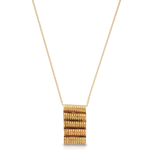



Achaemenid
Gold tubular pendant, Achaemenid, circa 5th - 4th century BC
Gold
Length: 2.2 cm
Length of chain: 18 in (adjustable to 16 in)
Length of chain: 18 in (adjustable to 16 in)
Further images
An ancient Achaemenid gold bead pendant composed of five ribbed hollow tubes connected together horizontally. With a modern gold chain.
An ancient Achaemenid gold bead pendant composed of five ribbed hollow tubes connected together horizontally. With a modern gold chain.
Provenance
Private collection, UK, acquired circa 2000Literature
Such beads would have been incorporated into larger pieces of jewellery. There are similar 5th century BC Greek tubular examples from Amathus, now in the British Museum, acc no. 1894.II-I.454-6: see J. Ogden and D. Williams, Greek Gold. Jewellery of the Classical World, London, 1994, p. 233, no. 166; also no. 178 (from Kourion).There are also similar 5th - 4th century BC Achaemenid examples from the Oxus Treasure, see British Museum, London accession no. 124079. The Oxus Treasure, discovered at the end of the 19th century by the Oxus River, is one of the most precious collections of ancient Persian art. Comprised of stunning gold and silver artworks and jewellery, the treasure is an impressive example of ancient Persian wealth. The elaborately decorated metalwork shows how incredibly skilful and talented artists were in the Achaemenid Empire.



